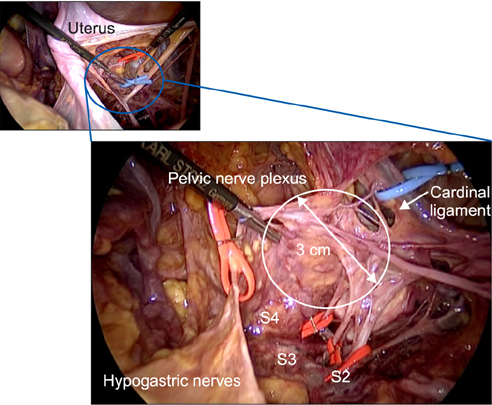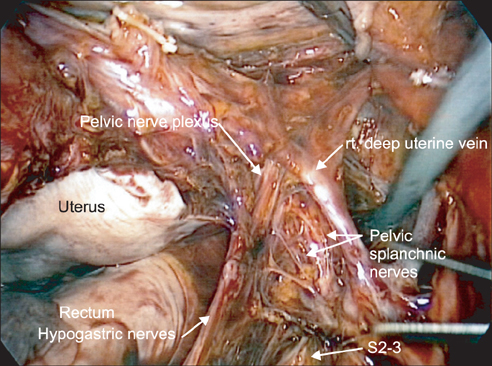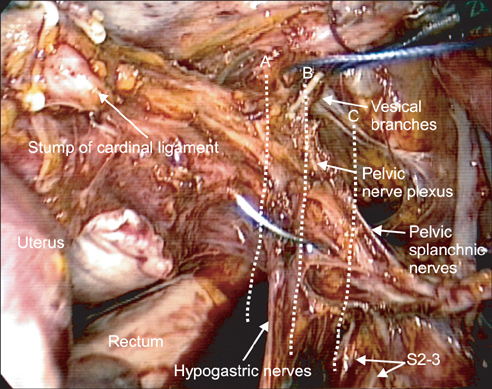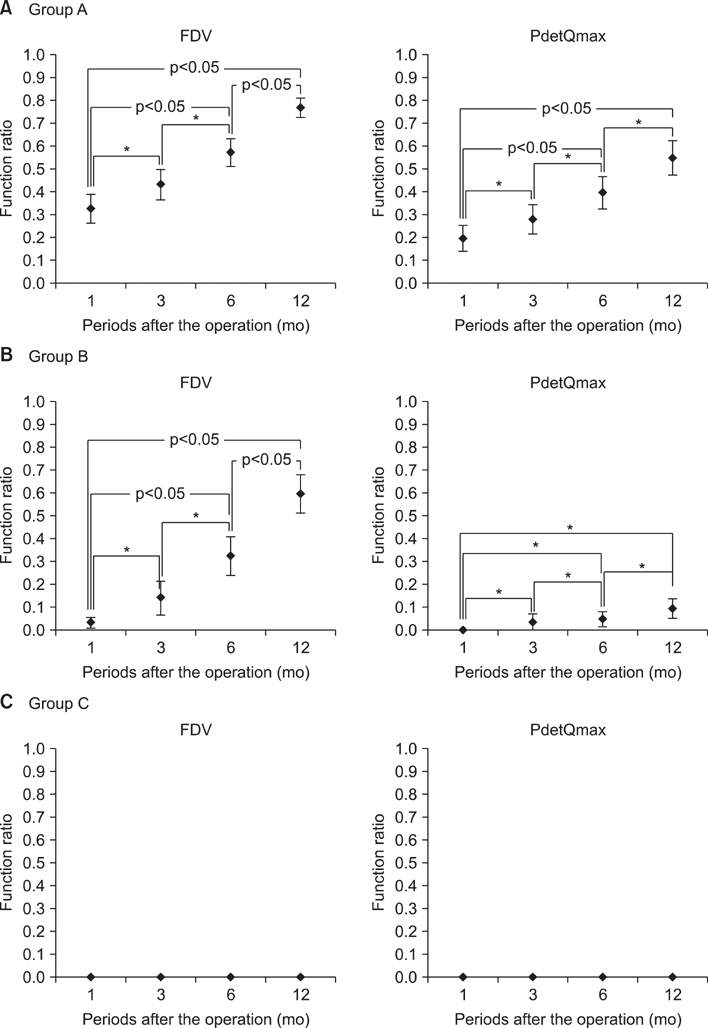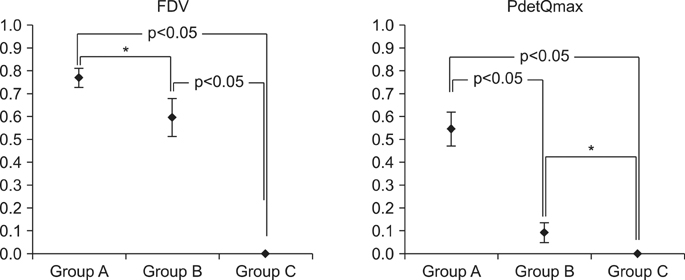J Gynecol Oncol.
2014 Jul;25(3):198-205. 10.3802/jgo.2014.25.3.198.
Various types of total laparoscopic nerve-sparing radical hysterectomies and their effects on bladder function
- Affiliations
-
- 1Department of Obstetrics and Gynecology, Kurashiki Medical Center, Kurashiki, Japan. b9g05tn0@ms11.megaegg.ne.jp
- KMID: 2130100
- DOI: http://doi.org/10.3802/jgo.2014.25.3.198
Abstract
OBJECTIVE
This study was conducted to ascertain the correlation between preserved pelvic nerve networks and bladder function after laparoscopic nerve-sparing radical hysterectomy.
METHODS
Between 2009 and 2011, 53 patients underwent total laparoscopic radical hysterectomies. They were categorized into groups A, B, and C based on the status of preserved pelvic nerve networks: complete preservation of the pelvic nerve plexus (group A, 27 cases); partial preservation (group B, 13 cases); and complete sacrifice (group C, 13 cases). To evaluate bladder function, urodynamic studies were conducted preoperatively and postoperatively at 1, 3, 6, and 12 months after surgery.
RESULTS
No significant difference in sensory function was found between groups A and B. However, the sensory function of group C was significantly lower than that of the other groups. Group A had significantly better motor function than groups B and C. No significant difference in motor function was found between groups B and C. Results showed that the sensory nerve is distributed predominantly at the dorsal half of the pelvic nerve networks, but the motor nerve is predominantly distributed at the ventral half.
CONCLUSION
Various types of total laparoscopic nerve-sparing radical hysterectomies can be tailored to patients with cervical carcinomas.
Keyword
MeSH Terms
-
Adult
Aged
Female
Humans
Hypogastric Plexus/injuries
Hysterectomy/adverse effects/*methods
Laparoscopy/adverse effects/*methods
Middle Aged
Neoplasm Staging
Pelvis/innervation
Peripheral Nerve Injuries/etiology/*prevention & control
Postoperative Period
Urinary Bladder/*innervation/physiopathology
Urodynamics
Uterine Cervical Neoplasms/pathology/*surgery
Figure
Cited by 2 articles
-
Feasibility and outcome of total laparoscopic radical hysterectomy with no-look no-touch technique for FIGO IB1 cervical cancer
Hiroyuki Kanao, Koji Matsuo, Yoichi Aoki, Terumi Tanigawa, Hidetaka Nomura, Sanshiro Okamoto, Nobuhiro Takeshima
J Gynecol Oncol. 2019;30(3):. doi: 10.3802/jgo.2019.30.e71.Efficacy and oncologic safety of nerve-sparing radical hysterectomy for cervical cancer: a randomized controlled trial
Ju-Won Roh, Dong Ock Lee, Dong Hoon Suh, Myong Cheol Lim, Sang-Soo Seo, Jinsoo Chung, Sun Lee, Sang-Yoon Park
J Gynecol Oncol. 2015;26(2):90-99. doi: 10.3802/jgo.2015.26.2.90.
Reference
-
1. Simsek T, Ozekinci M, Saruhan Z, Sever B, Pestereli E. Laparoscopic surgery compared to traditional abdominal surgery in the management of early stage cervical cancer. Eur J Gynaecol Oncol. 2012; 33:395–398.2. Pellegrino A, Vizza E, Fruscio R, Villa A, Corrado G, Villa M, et al. Total laparoscopic radical hysterectomy and pelvic lymphadenectomy in patients with Ib1 stage cervical cancer: analysis of surgical and oncological outcome. Eur J Surg Oncol. 2009; 35:98–103.3. Vizza E, Pellegrino A, Milani R, Fruscio R, Baiocco E, Cognetti F, et al. Total laparoscopic radical hysterectomy and pelvic lymphadenectomy in locally advanced stage IB2-IIB cervical cancer patients after neoadjuvant chemotherapy. Eur J Surg Oncol. 2011; 37:364–369.4. Colombo PE, Bertrand MM, Gutowski M, Mourregot A, Fabbro M, Saint-Aubert B, et al. Total laparoscopic radical hysterectomy for locally advanced cervical carcinoma (stages IIB, IIA and bulky stages IB) after concurrent chemoradiation therapy: surgical morbidity and oncological results. Gynecol Oncol. 2009; 114:404–409.5. Glahn BE. The neurogenic factor in vesical dysfunction following radical hysterectomy for carcinoma of the cervix. Scand J Urol Nephrol. 1970; 4:107–116.6. Seski JC, Diokno AC. Bladder dysfunction after radical abdominal hysterectomy. Am J Obstet Gynecol. 1977; 128:643–651.7. Fishman IJ, Shabsigh R, Kaplan AL. Lower urinary tract dysfunction after radical hysterectomy for carcinoma of cervix. Urology. 1986; 28:462–468.8. Kavallaris A, Hornemann A, Chalvatzas N, Luedders D, Diedrich K, Bohlmann MK. Laparoscopic nerve-sparing radical hysterectomy: description of the technique and patients' outcome. Gynecol Oncol. 2010; 119:198–201.9. Liang Z, Chen Y, Xu H, Li Y, Wang D. Laparoscopic nerve-sparing radical hysterectomy with fascia space dissection technique for cervical cancer: description of technique and outcomes. Gynecol Oncol. 2010; 119:202–207.10. Plotti F, Zullo MA, Montera R, Angioli R, Pierluigi BP. Bladder function after laparoscopic nerve-sparing radical hysterectomy. Gynecol Oncol. 2011; 120:315.11. Benedetti-Panici P, Zullo MA, Plotti F, Manci N, Muzii L, Angioli R. Long-term bladder function in patients with locally advanced cervical carcinoma treated with neoadjuvant chemotherapy and type 3-4 radical hysterectomy. Cancer. 2004; 100:2110–2117.12. Yamaguchi K, Kobayashi M, Kato T, Akita K. Origins and distribution of nerves to the female urinary bladder: new anatomical findings in the sex differences. Clin Anat. 2011; 24:880–885.13. Malzoni M, Tinelli R, Cosentino F, Fusco A, Malzoni C. Total laparoscopic radical hysterectomy versus abdominal radical hysterectomy with lymphadenectomy in patients with early cervical cancer: our experience. Ann Surg Oncol. 2009; 16:1316–1323.14. Li G, Yan X, Shang H, Wang G, Chen L, Han Y. A comparison of laparoscopic radical hysterectomy and pelvic lymphadenectomy and laparotomy in the treatment of Ib-IIa cervical cancer. Gynecol Oncol. 2007; 105:176–180.15. Taylor SE, McBee WC Jr, Richard SD, Edwards RP. Radical hysterectomy for early stage cervical cancer: laparoscopy versus laparotomy. JSLS. 2011; 15:213–217.16. Lee EJ, Kang H, Kim DH. A comparative study of laparoscopic radical hysterectomy with radical abdominal hysterectomy for early-stage cervical cancer: a long-term follow-up study. Eur J Obstet Gynecol Reprod Biol. 2011; 156:83–86.17. Sobiczewski P, Bidzinski M, Derlatka P, Panek G, Danska-Bidzinska A, Gmyrek L, et al. Early cervical cancer managed by laparoscopy and conventional surgery: comparison of treatment results. Int J Gynecol Cancer. 2009; 19:1390–1395.18. Nam JH, Park JY, Kim DY, Kim JH, Kim YM, Kim YT. Laparoscopic versus open radical hysterectomy in early-stage cervical cancer: long-term survival outcomes in a matched cohort study. Ann Oncol. 2012; 23:903–911.19. Park NY, Chong GO, Hong DG, Cho YL, Park IS, Lee YS. Oncologic results and surgical morbidity of laparoscopic nerve-sparing radical hysterectomy in the treatment of FIGO stage IB cervical cancer: long-term follow-up. Int J Gynecol Cancer. 2011; 21:355–362.20. Lin HH, Yu HJ, Sheu BC, Huang SC. Importance of urodynamic study before radical hysterectomy for cervical cancer. Gynecol Oncol. 2001; 81:270–272.21. Andersson KE. Bladder activation: afferent mechanisms. Urology. 2002; 59:5 Suppl 1. 43–50.22. Ralph G, Tamussino K, Lichtenegger W. Urological complications after radical abdominal hysterectomy for cervical cancer. Baillieres Clin Obstet Gynaecol. 1988; 2:943–952.
- Full Text Links
- Actions
-
Cited
- CITED
-
- Close
- Share
- Similar articles
-
- Minimally invasive surgery improves short-term outcomes of nerve-sparing radical hysterectomy in patients with cervical cancer: a propensity-matched analysis with open abdominal surgery
- Nerve and Seminal Sparing Cystectomy for Bladder Cancer
- Clinical Characteristics of Urinary-Vaginal Fistulas After Various types of hysterectomy
- Urodynamic study of bladder function following nerve sparing radical hysterectomy
- Total Laparoscopic Hysterectomy using Modified Bae's Uterine Elevator

